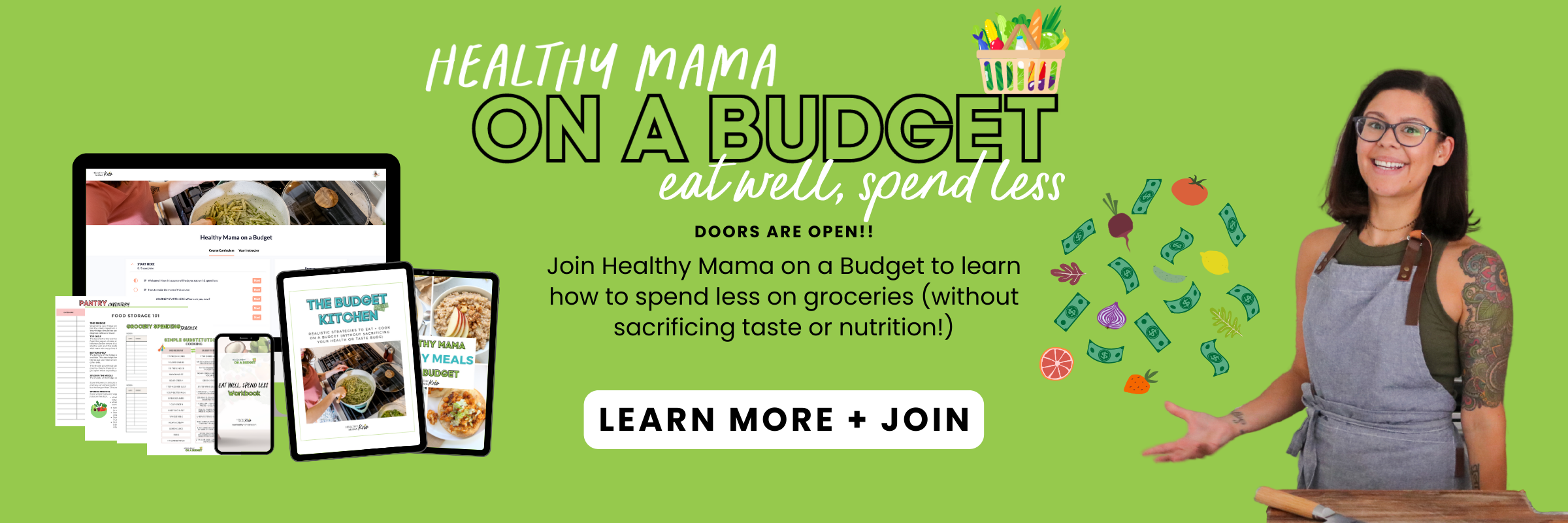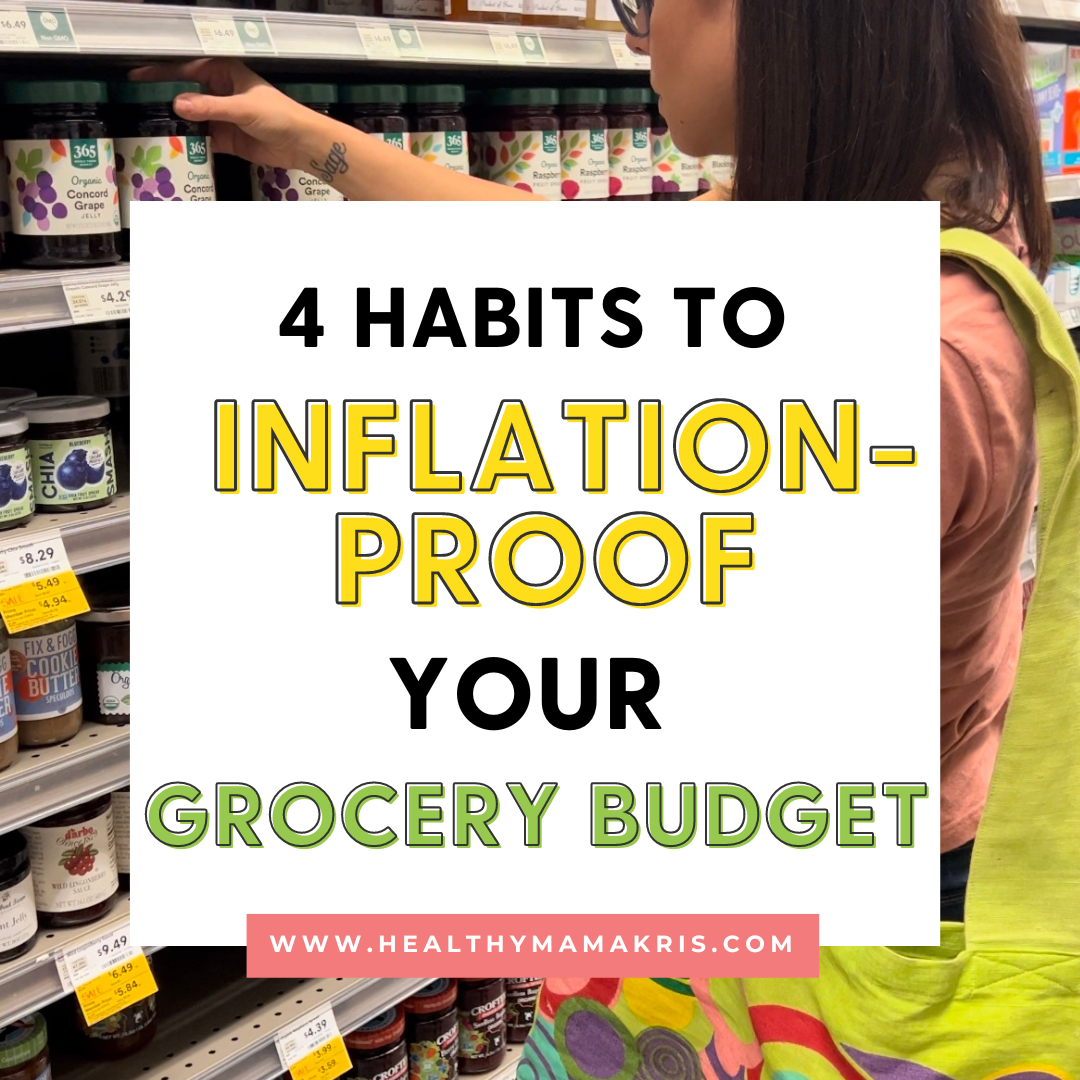I’ve been talking about grocery budgeting since 2018 (almost five years, now!), when I was working full time as a health coach and recipe developer, and so many of my then-clients came to me, stressed that eating healthy was so expensive.
This shocked me, at first– but what I realized was there were so many little habits I had put in place to make healthy eating affordable, without even thinking too much about it (I’m not some magical budget unicorn, though- I’ll share why in a second!).
This isn’t to say we never over-spent on groceries (my husband can attest to my occasional $350 “Whoops!” Trader Joes splurges) but we had been through a personal finance course, paid off thousands of dollars in debt- and interestingly, whenever we focused on our grocery spending, we found it wasn’t a big issue (now date night at restaurants and Target trips on the other hand… 😉).
The reason was I had a good grasp on what it took to make small tweaks to reduce my spending, without changing the way we eat. Let me stress this wasn’t something I was inherently good at– I knew nothing about budgeting food until I became a personal chef- budgeting other people’s groceries meant I needed to learn how to shop smart, fast.
It was (and is) about intention and good habits that makes spending less on groceries while still eating really well possible.
Now, in 2018 I was spending a less on food than I am now– because it was only myself and my husband, a four year old and a baby to feed– but even five years later, with a five and a nine year old who eat nearly as much as I do (we’ve graduated from kids meals at restaurants for one-why didn’t anyone warn me about this?!), we still only spend around $600 a month on groceries for our family of four, eating lots of real, whole foods, eating out 1-2x a week (usually a date night and a lunch). That means we’re spending about $7.32 cents a meal, on average.
But then… inflation.
What’s a mama to do when everything at the store is suddenly more expensive than it was, even six months ago? How should we adjust our budget if food costs more, now?
I don’t think you need to (seriously!).
There is SO MUCH more to spending less on food than the prices at the grocery store.
And yes, the prices at the store matter– but it’s your habits OUTSIDE the grocery store that matter MORE.
Here are four habits that have helped us inflation-proof our grocery budget:
1. I’m really intentional about my meal plan.
Now, please hear me when I say this does NOT take me a ton of time. 10-15 minutes a week, max- and one of the reasons is because I’ve created habits around my meal plan that make it EASY- like having a family favorites list and a recipes to try list, so I’m not sorting through every recipe in the universe to decide what to cook (p.s. If you want done for you family-friendly meal plans each week, check out the Healthy Mama Cooking Club– it’s only $3 a month and you can try your first week free!).
I’m also intentional about using up ingredients– especially using ingredients in multiple meals to avoid food waste (when we throw away food, we’re throwing away money!). It’s also been really helpful to not over-plan, so I don’t end up with more food than we need in the fridge. I plan for five days, one day is a break for me- a date night or a family night- and a leftovers or ‘use what we have’ night to use up any of those leftover bits and odds and ends we have on hand.
Read more: Four Meal Planning Hacks to Save on Food
2. I only shop once a week.
Studies show the more time we spend in the store and the more often we shop, the more we spend. Ever popped into the grocery store for ‘just one thing’ and ended up with a cart full? Even if you just throw one extra $5 item in your cart per week, that’s $260 a year. Do this three times and that’s $780 a year. $780 might not seem like a lot- but that’s about the cost of a flight from Boston to London (I’m just saying…).
This one habit has been a game changer for me and many of the women who have gone through Healthy Mama on a Budget. If you are a multiple-times-a-week shopper, try it for a month- and see how it makes a difference!
3. I check my fridge, freezer and pantry before planning to focus on using what we have before buying new.
So often we buy those extra things that the store that we don’t need- or don’t get used up- and they pile up in our pantry and our freezer (often to be thrown away in a year when you do your annual spring cleaning!). But what if you were intentional about using the items you have when you plan your meals- instead of letting them collect dust? Everything you use from what you have is something you don’t have to buy.
4. We eat a lot of the same meals.
We get a LOT of variety– don’t get me wrong (check out some of our recent monthly eat on my Instagram here and here) but eating lots of similar meals throughout the month means we can be strategic about how we stock up on food, saving the most we can on staple items by buying in bulk at Costco or Thrive Market (usually I alternate months, for these, as I buy different items at each one). Doing a monthly stock-up of staple items and shopping for fresh items in between has been a HUGE game changer for being more consistent in our spending over the last several years, even with inflation.
Some of our go-to meals we come back to again and again:
- Five Veggie Meat Sauce (usually with Banza chickpea pasta, which we buy in bulk)
- Shrimp Fried Rice
- Roast Chicken (leftovers turned into Comfy Chicken Soup)
- White Chicken Chili
- Green Chile Chicken Enchiladas
- Cauliflower Crust Shepherd’s Pie
- Beef & Butternut Squash Chili
- Cobb Salads with homemade ranch
- Taco Night (with my homemade taco seasoning)
- Chicken Gnocchi Soup
- Five Ingredient Meatballs
- Greek Style Marinated Chicken Wraps
- Allll the bowls!
THE HEALTHY MAMA ON A BUDGET SPRING SALE IS HERE! 🌸🛒🥦💵 For a limited time, get 25% off the course + budget kitchen guide AND my brand-new free e-book, Simply from Scratch, with 15 upleveled budget-friendly base recipes to make from home, instead of buying (think just like Nonna’s marinara, better than canned refried beans and roasted tomato salsa, clucking good chicken tenders and more!). Get it all for less than $75 now!

Read more:
10 things we do to spend $600 a month to feed our family of four (with LOTS of real, whole foods!)
4 Meal Planning Hacks to save money on food

Leave a Reply Cancel reply
5-day series: how to get started with meal prep for easier meals
free email series
©️ 2025 Kristin Dovbniak for Healthy Mama Kris | Template by Maya Palmer Designs | Privacy Policy | Terms